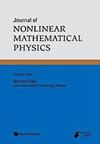通过改进的黎曼-希尔伯特方法求得衍生非线性薛定谔方程的高阶孤子解
IF 1.6
4区 物理与天体物理
Q2 MATHEMATICS, APPLIED
引用次数: 0
摘要
本文讨论了一种改进的黎曼-希尔伯特方法,通过这种方法可以直接得到导数非线性薛定谔方程的任意高阶孤子解。本文给出了与一个 pth 阶极点相对应的高阶孤子的显式行列式。此外,还考虑了与一个简单极点和另一个双极点相关的相互作用。本文章由计算机程序翻译,如有差异,请以英文原文为准。

Higher-Order Soliton Solutions for the Derivative Nonlinear Schrödinger Equation via Improved Riemann–Hilbert Method
In this paper we discuss an improved Riemann–Hilbert method, by which arbitrary higher-order soliton solutions for the derivative nonlinear Schrödinger equation can be directly obtained. The explicit determinant form of a higher-order soliton which corresponds to one pth order pole is given. Besides the interaction related to one simple pole and the other one double pole is considered.
求助全文
通过发布文献求助,成功后即可免费获取论文全文。
去求助
来源期刊

Journal of Nonlinear Mathematical Physics
PHYSICS, MATHEMATICAL-PHYSICS, MATHEMATICAL
CiteScore
1.60
自引率
0.00%
发文量
67
审稿时长
3 months
期刊介绍:
Journal of Nonlinear Mathematical Physics (JNMP) publishes research papers on fundamental mathematical and computational methods in mathematical physics in the form of Letters, Articles, and Review Articles.
Journal of Nonlinear Mathematical Physics is a mathematical journal devoted to the publication of research papers concerned with the description, solution, and applications of nonlinear problems in physics and mathematics.
The main subjects are:
-Nonlinear Equations of Mathematical Physics-
Quantum Algebras and Integrability-
Discrete Integrable Systems and Discrete Geometry-
Applications of Lie Group Theory and Lie Algebras-
Non-Commutative Geometry-
Super Geometry and Super Integrable System-
Integrability and Nonintegrability, Painleve Analysis-
Inverse Scattering Method-
Geometry of Soliton Equations and Applications of Twistor Theory-
Classical and Quantum Many Body Problems-
Deformation and Geometric Quantization-
Instanton, Monopoles and Gauge Theory-
Differential Geometry and Mathematical Physics
 求助内容:
求助内容: 应助结果提醒方式:
应助结果提醒方式:


